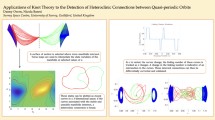Abstract
A method for the determination of accurate analytical expressions for the time dependence of the relative motion of two noninteracting masses under the gravitational influence of a spherical primary mass is presented and discussed. The case of the elliptic reference orbit is considered and the case of a circular reference orbit is analyzed as a special case. The approach also leads to accurate initial conditions for the elimination of drift away from periodic relative motion. The solution for the relative motion is in closed-form in terms of the eccentric anomalies of the target and chaser orbits, while the eccentric anomalies themselves are expressed in terms of the orbits’ respective eccentricities, using an iterative method.
Similar content being viewed by others
References
BROUCKE, R. A. “Solution of the Elliptic Rendezvous Problem with the Time as Independent Variable,” Journal of Guidance, Control, and Dynamics, Vol. 26, No. 4, July-August 2003, pp. 615–621.
CLOHESSY, W. H. and WILTSHIRE, R. S. “Terminal Guidance System for Satellite Rendezvous,” Journal of Aerospace Sciences, Vol. 27, 1960, pp. 653–658 and 674.
COLWELL, P. Solving Kepler’s Equation over Three Centuries, Willmann-Bell Inc., 1993.
HALE, F. J. Introduction to Spaceflight, Prentice Hall, 1994.
KONG, E. M. C., MILLER, D. W., and SEDWICK, R. J. “Exploiting Orbital Dynamics for Aperture Synthesis Using Distributed Satellite Systems: Application to a Visible Earth Imager System,” The Journal of the Astronautical Sciences, Vol. 47, Nos. 1 and 2, January–June 1999, pp. 53–75.
MELTON, R. G. “Time-Explicit Representation of Relative Motion Between Elliptical Orbits,” Journal of Guidance, Control, and Dynamics, Vol. 24, No. 4, 2000, pp. 604–610.
PRUSSING, J. E. and CONWAY, B. A. Orbital Mechanics, Oxford University Press, 1993.
RICHARDSON, D. L. and MITCHELL, J. W. “A Third Order Analytical Solution for Relative Motion with a Circular Reference Orbit,” The Journal of the Astronautical Sciences, Vol. 51, No. 1, 2003, pp. 1–12.
SABOL, C., BURNS, R., and MCLAUGHLIN, C. A. “Satellite Formation Flying Design and Evolution,” Journal of Spacecraft and Rockets, Vol. 38, No. 2, 2001, pp. 270–278.
SCHARF, D. P., HADAEGH, F. Y., and PLOEN, S. R. “A Survey of Spacecraft Formation Flying Guidance and Control (Part I): Guidance,” Proceedings of the American Control Conference, Denver, Colorado, June 4–6, 2003.
SCHWEIGHART, S. A., and SEDWICK, R. “High Fidelity Linearized J2 Model for Satellite Formation Flight,” Journal of Guidance, Control, and Dynamics, Vol. 25, No. 6, 2002, pp. 1073–1080.
SZEBEHELY, V. G. Theory of Orbits, the Restricted Problem of Three Bodies, Academic Press, New York, 1967.
TSCHAUNER, J. “Elliptic Orbit Rendezvous,” AIAA Journal, Vol. 5, No. 6, pp. 1110–1113.
Author information
Authors and Affiliations
Rights and permissions
About this article
Cite this article
Ketema, Y. An Analytical Solution for Relative Motion with an Elliptic Reference Orbit. J of Astronaut Sci 53, 373–389 (2005). https://doi.org/10.1007/BF03546359
Published:
Issue Date:
DOI: https://doi.org/10.1007/BF03546359




